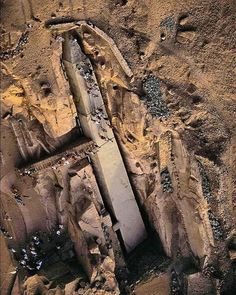
The sands of Egypt hold within them the remnants of a civilization that thrived thousands of years ago, leaving behind marvels of engineering and architecture that continue to awe and inspire. Among these treasures is the Unfinished Obelisk of Aswan, a testament to the ambitious undertakings of ancient Egyptian craftsmen. In this article, we delve into the history and significance of the Unfinished Obelisk, shedding light on its intended purpose and the engineering marvels it represents.
The Unfinished Obelisk: A Glimpse into Ancient Egyptian Mastery
Carved from the bedrock of the Aswan quarry, the Unfinished Obelisk stands as a testament to the ingenuity and craftsmanship of ancient Egyptian artisans. Estimated to weigh a staggering 1,200 tons and measuring approximately 42 meters (137 feet) in length, the obelisk was intended to be one of the largest ever erected, destined for the Karnak Temple in Luxor, over 210 kilometers (130 miles) away. However, its journey to completion was abruptly halted by a fracture in the granite, leaving the obelisk abandoned in the quarry for millennia.
Engineering Marvels and Construction Techniques
The construction of the Unfinished Obelisk provides valuable insights into the engineering prowess of ancient Egypt. Using primitive tools such as chisels, hammers, and wedges made of dolerite and other hard stones, craftsmen meticulously carved away at the granite bedrock, gradually shaping the obelisk to its intended form.

The precision and skill required to undertake such a monumental task without the aid of modern technology are a testament to the dedication and expertise of ancient Egyptian artisans.
Intended Purpose and Symbolism
The obelisk held profound significance in ancient Egyptian culture, symbolizing the sun god Ra and serving as a representation of divine power and authority. Erected in temple complexes as votive offerings or commemorative monuments, obelisks played a central role in religious ceremonies and rituals, aligning with the celestial movements of the sun and serving as focal points for worship and reverence. The Unfinished Obelisk, had it been completed and transported to Karnak Temple, would have stood as a monumental testament to the glory of ancient Egypt’s religious and architectural achievements.
Preservation Efforts and Visitor Attractions
Today, the Unfinished Obelisk remains a captivating attraction for visitors to Aswan, offering a glimpse into the ancient techniques and craftsmanship employed by Egyptian artisans. Efforts to preserve and protect the site ensure that future generations can continue to marvel at this remarkable feat of engineering and explore its historical significance.

Guided tours and educational programs provide insights into the construction techniques used by ancient craftsmen, allowing visitors to immerse themselves in the rich cultural heritage of Egypt.
In Conclusion: A Monumental Legacy
In conclusion, the Unfinished Obelisk of Aswan stands as a lasting testament to the skill, dedication, and ingenuity of ancient Egyptian craftsmen. Despite its incomplete state, the obelisk serves as a reminder of the grandeur and sophistication of Egypt’s ancient civilization, offering valuable insights into the engineering marvels and cultural symbolism of the time. As a revered relic of Egypt’s past, the Unfinished Obelisk continues to inspire awe and admiration, captivating visitors with its monumental legacy and timeless allure.





